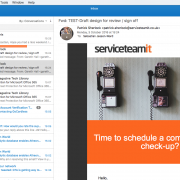Cloud Platforms & Applications: Most UK companies are working with a hybrid cloud approach and with multiple vendors, in combination with in house data centres for their cloud platform. Adoption of cloud is now varied and widespread, as the research from the UK Cloud Snapshot Survey 2017 demonstrates. The survey asked what platforms were being used for delivery of cloud based solutions.
of respondents have an in house data centre
Or they have hosting resource that makes up an element of their cloud solutions. These include legacy systems as well as the strategic deployment of hardware. The interviews showed divided opinion about in house hosting, with an even split between those who believe that data is always going to be more secure if it is directly under their control and those who feel that large scale cloud platform providers have a level of resource that results in a higher level of security than can ever be delivered in house. Half of the respondents use third party data centres for collocation of server and network equipment.
Cloud Platform Market Battle
Amazon Web Services (AWS)
Microsoft Azure
Google Cloud Platform
The battle of the large scale cloud platforms is hotting up, the Microsoft Azure share of the market is growing at a rate faster than AWS but is safe to say that currently, globally AWS has the largest market share at around 40%, with Azure, Google and IBM making up just 23% combined (Synergy Research Group).
In April 2017 Amazon, Microsoft and Alphabet all reported quarterly results on the same day. Amazon was the only company to present clear numbers for its infrastructure business showing an annualised run rate of $14.6 billion. Microsoft bundles its Azure business into the Intelligent Cloud division, which includes various other servers and cloud services. In total, that business grew 11% to $6.8 billion. While Microsoft does not split out Azure’s revenue, it does give a growth number. In the quarter ended March 2017, sales increased by 93%. Giving Microsoft a Commercial Cloud business with annualised revenue of $15.2 billion, including Office 365 and not just the Azure infrastructure service. Alphabet did not provide a figure for the Google Cloud Platform, including it only in the $3.1 billion figure left after removing advertising revenue from their $24.5 billion quarter. Other providers of cloud platforms such as HPE Helion and Oracle Cloud made up just 9% of the total cloud platform used by the survey respondents.
Cloud Applications Maturity
Productivity
We sought to discover which applications were being used on these cloud platforms and also which applications were provided in the cloud model. As the survey did not cover areas such as farming or manufacturing and most responses to the survey were companies with largely office based staff it is not surprising that most of the companies said that they used cloud based productivity tools such as Microsoft Office 365 or Google Apps. 77% of respondents said they used either one or both of the productivity suites. It is estimated that around 60% of organisations globally have adopted either Office 365 or Google apps and according to Gartner, the split between enterprise adoption of Office 365 over Google apps is around 2:1. There is crossover between companies who use both sets of productivity applications, due to third party application integrations and avoidance of disruptive change within a base that is familiar with certain products.
Storage
With storage costs being as low as $0.02 per GB per month most companies are utilising cloud based platforms for storage. With increasing consolidation and projects to simplify data policies in a post-GDPR Britain the use of cloud based storage will only increase. 60% of responding companies said they used cloud based storage. Security concerns over safeguarding stakeholders’ information and private data majorly restrains the cloud storage deployment in certain verticals but for most small to mid-sized businesses, the cost benefits outweigh some of those concerns. Storage is a large part of the hybrid solutions used by many companies. Services such as Microsoft OneDrive, Dropbox and Google Drive were not included in the answers to this question.
Database
56% of companies use databases on cloud platforms. These combine the benefits of running a database on a VM or database as a service (DBaaS) such as Amazon Relational Database Service or Microsoft Azure SQL Database. The global DBaaS market is highly fragmented due to the presence of many large and small vendors. Cloud-based Database market size is predicted to maintain the average annual growth rate of 24% as companies move an increasing amount of databases to the cloud to benefit from the relative simplicity of deploying resilient data base services.
Security
Legacy security solutions are no longer as effective at providing protection, and on-premises hardware often lacks the sufficient scale and performance to protect Internet-facing application infrastructure as it grows. Over 1/3 (37%) of companies responding to the survey have adopted cloud based security services such as Multi-Factor Authentication and Single Sign-On. Cloud security providers typically have greater visibility of attacks and attack patterns than any individual company. They make real time threat intelligence available as well as threat updates to companies, including through improved web application firewall rules, new attack signatures, customer-facing threat advisories and better internal response processes. By defending against attacks directed at multiple organizations, cloud security providers develop significant expertise and experience, on which they can draw when mitigating future attacks to help reduce customer impact and the time to resolve the instance.
Analytics
The promise of business insight from Big Data through quality analytics is now a reality in most businesses. Cloud analytics is a service model in which elements of the data analytics process are provided through a public or private cloud and it has been adopted by a third of the survey respondents. Gartner defines the six key elements of analytics as data sources, data models, processing applications, computing power, analytic models and sharing or storage of results. Gartner states that any analytics initiative “in which one or more of these elements is implemented in the cloud” qualifies as cloud analytics. From Oracle to Microsoft Power BI it is clear that the use of cloud analytics will grow larger over the coming year.
Enterprise Cloud Platform
Part of the consumerisation of the enterprise is the adoption of enterprise grade cloud applications such as Oracle and Salesforce. com. One large change that has been observed over the past year is a growth in consumption of enterprise cloud applications. There has been an increase in both the number of applications moving to the public cloud marketplace as well as increasing the ease of consumption of these enterprise cloud applications. In the past, enterprises needed to open up conversations with the vendors, complete an RFP process and then work through the process to select and deploy an enterprise software solution. Today, an organization can go to a public cloud marketplace and, with just a few clicks, spin up an instance of Microsoft Dynamics, SharePoint or other business applications. Overall 35% of respondents said they were using cloud based enterprise applications, in the Scientific research section this was nearly every company, however, in the insurance sector, it was just 14% of the respondents, this may reflect the more traditional nature of the insurance markets.
Managing the public cloud estate, hybrid estate or enterprise applications requires the use of cloud based management tools such as Amazon CloudWatch, CA Unified Infrastructure Management or Cisco CloudCenter (formerly CliQr). Other smaller companies have arrived to provide cloud management services such as Cloud Ranger and Dynatrace. Some of these are very powerful and very easy to adopt. Nearly a quarter (23%) singled out cloud management tools as a key application they use across their cloud platforms as they give them far greater visibility and control over their infrastructure than could be achieved in traditional computing.









